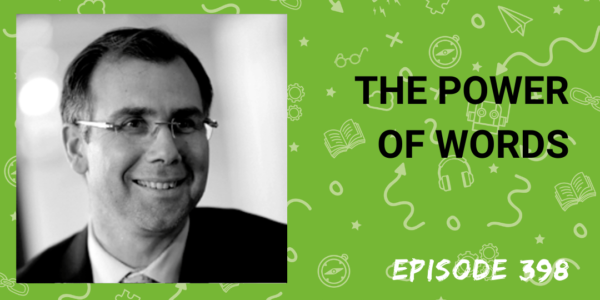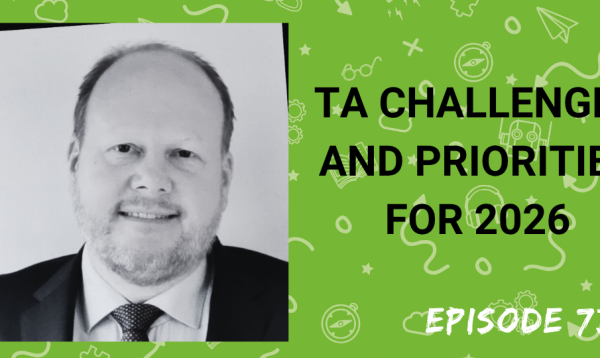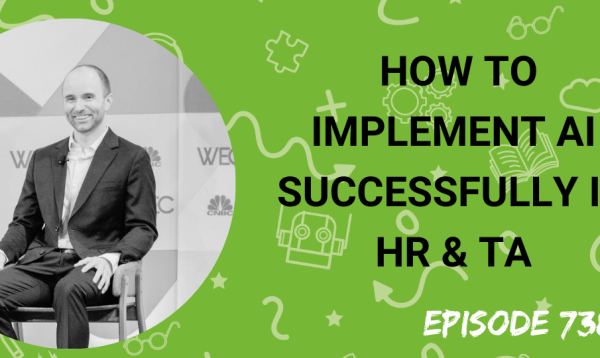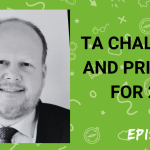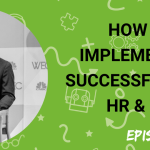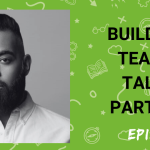One of the things I have been doing on the show this year is investigating new technologies in the assessment market. As the speed of adoption increases, it’s essential to understand the actual science behind what is being developed.
I’ve always been fascinated by language and what we might be able to learn from the words that people use. With that in mind, I was very keen to talk to this week’s guest. Mike Durland is CEO of Receptiviti. Receptiviti has a robust scientific methodology that uses language data to uncover emotions, personality, and psychology.
This is essentially an interview in two parts. In the first half of our conversation, Mike talks about what we can learn from applying science to language. In the second half of the conversation, he shares some important insights that Receptivit has uncovered about the effect of remote and hybrid working on different parts of the workforce. It’s fascinating stuff.
In the interview, we discuss:
• The relationship between psychology and language
• The secret life of pronouns
• Applications for recruiting
• What are people saying about work?
• How happy are people working from home?
• Has the pandemic driven an increase in empathy at work?
• The different effects of the pandemic on senior and junior employees
• How to be a great place to work
• What can we expect in the future?
Listen to this podcast in Apple Podcasts.
Interview transcript:
Eightfold.ai (Ad) (0s):
Support for this podcast comes from Eightfold.ai. Eightfold.ai delivers the talent intelligence platform in the most effective way for companies to retain top performers, upscale and rescale the workforce, recruit top talent efficiently, and reach diversity goals. Eightfold.ai’s deep learning artificial intelligence platform empowers enterprises to turn talent management into a competitive advantage.
Matt Alder (46s):
Hi, everyone. This is Matt Alder. Welcome to episode 398 of the Recruiting Future Podcast. One of the things I have been doing on the show this year is investigating new technologies in the assessment market. As the speed of adoption increases, it’s essential that we understand the actual science behind what’s being developed. I’ve always been fascinated by language and what we might be able to learn from the words that people use. With that in mind, I was very keen to talk to you this week. My guest, Mike Durland, is the CEO of Receptiviti. Receptiviti has a robust scientific methodology that uses language data to uncover emotions, personality, and psychology.
Matt Alder (1m 33s):
This is essentially an interview in two parts. In the first half of our conversation, Mike talks about what we can learn from applying science to language. In the second half of the conversation, he shares some important insights that Receptiviti has uncovered about the effect of remote and hybrid working on different parts of the workforce. It’s fascinating stuff. Hi, Mike, and welcome to the Podcast.
Mike Durland (2m 0s):
Thank you very much. Great to be here.
Matt Alder (2m 3s):
An absolute pleasure to have you on the show. Could you just introduce yourself and tell us what you do?
Mike Durland (2m 8s):
I would love to. My name is Mike Durland. Again, thank you very much for inviting me to join you today and also would like to say congratulations to you on this fantastic podcast. I think you’re approaching your 400th episode, which is amazing. A little bit of my background, I am currently helping to lead a very interesting company called Receptiviti. I was a C-level executive at a large global financial institution based in Canada. I also have an academic background.
Mike Durland (2m 50s):
I have a Ph.D. in management and I’ve always been very deeply fascinated by people. I spent many years coaching amateur sport. My father was a coach. I’ve always been a student of leadership fascinated by how we build high-performance teams – what makes good people do good, what makes good people do bad, the secret life of culture, and so on. I’ve also always been deeply interested in technology. I started my career in technology and was very actively involved in technology during my executive career.
Mike Durland (3m 36s):
I was a client of a company called Receptiviti. As a client, I got to know the team, began to dig into the science, got a sense of the insights that they can derive. I was really blown away. I started investing in the company and a year and a half ago, I joined the team to lead the company, maybe a little bit of background just on Receptiviti. Receptiviti is a people insights company. We help our clients derive important business outcomes based on better understanding the people that are important to them.
Mike Durland (4m 16s):
We study how people speak, how they communicate. We study their language, their choice of words in written text, in the spoken text, or whatever form. From this everyday language, we derive really useful and actionable insights. These insights help our clients understand the emotions, personalities, drives, needs, values, emotional health of people who are important to them, and we can do this in depth, but we can also do this at scale. The insights might be on an individual person.
Mike Durland (4m 56s):
For example, they might be interested in recruitment or perhaps succession planning, or the insights can be more at the group level where we understand group dynamics, power, and balances, organizational health, so on. We do this every day. That’s all we do. We’re people insight company. Our company is filled with people with backgrounds in psychology, linguistics, data science, but also with people who have spent years of their lives working in large companies involved in senior levels of management, who have built teams and part of large cultures, and who understand deeply our mission as a company.
Mike Durland (5m 40s):
That’s a little bit of background.
Matt Alder (5m 42s):
Fantastic. There were a few reasons why I wanted to have you on the show. First of all, one of the things that we’ve been exploring in recent weeks and months, emerging ways to do assessment, to make decisions about people. I’m very interested in talking about your soul can be used and things like recruiting a little bit later in the conversation, but actually, I am absolutely fascinated by language, how we use it, how other people use it, and what we can learn about people from that language. What really stood out for me about your organization is the depth of science that sits behind it because I think there are lots of interesting tools on the market that assess people in different ways, but not many of them are based on the robust science that we would hope they were.
Matt Alder (6m 27s):
Obviously, your organization has a very, very strong scientific background to it. Tell us about the science behind what you do, how it works, and the kind of insights that it can produce.
Mike Durland (6m 40s):
Sure. Receptiviti was co-founded by a quite famous scientist named James Pennebaker. Jamie made several significant and important contributions to our understanding of social psychology, but perhaps its most important is the work that he has done studying the relationship between our psychology and our language when we are depressed, anxious, fearful, maybe self-absorbed, achievement-oriented, analytic, or authentic. How do we communicate this work led to the development of an important algorithm, which is known as Luke.
Mike Durland (7m 26s):
For those who are interested, Jamie wrote a great little book called The Secret Life of Pronouns, which is a quick read, great introduction to the science behind what we do, but the gist is as follows. The way we communicate are sometimes subtle and sometimes not. Subtle choices of words provides an amazing window into who we are. For example, when we’re focused on ourselves, we use the words I, me, my. We use these words a lot and we all recognize this example. We can think of cases where we’ve been in the room with a person who spoke that way.
Mike Durland (8m 11s):
“Who said I did this. I know him.” I think that my view is this is in contrast to a person who is more team-oriented that uses a broader set of social words, words like we, team, family, together. “This team made this happen. We should all feel very proud of this accomplishment together. We can do this.” Remember, “We are a family,” that’s very different than “I did this. I know him. I think that,” so forth. Another simple example is emotion. Words are emotion. Words also reveal a lot.
Mike Durland (8m 53s):
Are we excited or are we angry? Are we fearful? Are we thankful? Are we curious? Are we bored? Do we express a lot of emotion or do we express a little emotion? The core part of our science is derived from this algorithm called Luke. At its very simplest form, Luke counts words, but what makes Luke so interesting is the words that counts. We map words, common words, words that are used frequently in everyday language. We map these into categories that are psychologically purposeful designed to help us drive insights into the person behind the words.
Mike Durland (9m 42s):
We’ll go into a little bit more detail in how do we map those into important measures and insights?
Matt Alder (9m 57s):
Absolutely. I could talk about the science behind language all day, but I think we probably need to make this a little bit more tangible for the people listening. Obviously, a big proportion of the audience is working in talent acquisition and recruiting. They may recognize some of this thinking around language through other things that they’ve done and looked at, but tell us about how your type of technology can be used in recruiting and how it can drive better outcomes.
Mike Durland (10m 25s):
Yes, sure. Broadly speaking, there are, I guess, a couple of ways that we support our clients in the area of recruiting. One is to augment their existing process, and perhaps, at the other end of that spectrum, we are maybe automating a process to work at scale. Let’s start with the augmentation approach. The goal in recruiting obviously is to gain as much understanding as we possibly can about each of the potential candidates.
Mike Durland (11m 5s):
Ultimately, the goal is to select the best candidate and it’s a challenging exercise. What makes this challenging most of the time is that we’re assessing people that are total strangers so there are a variety of tools and techniques that we already use to make these assessments depending on the nature of the person that we’re recruiting seniority role. We might use self-assessments and it might be interviewed by a variety of people, each of whom will assess the person. These interviews provide a great source of language or text that we can study.
Mike Durland (11m 45s):
By studying this language, we can add another voice to the process, help provide an independent and hopefully unbiased assessment of this candidate. Each candidate crossed a set of attributes that are deemed to be important for the job in question so things like, what is the candidates personality? What drives them? What motivates them? Are they driven by reward achievement? Are they self-focused? Are they team players? All of these things we can help derive from language.
Mike Durland (12m 25s):
Of course, what we can do at depth, we can do at scale. We can process millions of words in a second, and a result, many of our clients use our insight engine to hire that volume for jobs like call centers, security guards, even for things like university admissions.
Matt Alder (12m 51s):
Got a question about how does your system get the language loaded into it? Is these from transcriptions or recordings? What’s the practicalities around that?
Mike Durland (13m 2s):
For a lot of our interview, type of use cases their transcriptions, a lot of interviews are now done on platforms like zoom, which provides transcriptions. In many cases, there are chatbot tools that are conducting more volume. MIS interviews could be collected that way. Whatever the source of language is, we can figure out how to get it transcribed and into a machine readable form.
Matt Alder (13m 40s):
Interesting. That really fits in with the way that the interviewing has developed over the last couple of years. A couple of times, you’ve alluded to the fact that your science can work in this the broader HR sphere at a team level. Obviously, organizations are in a quite unique situation at the moment in terms of disruption because of the pandemic – people working from home, people coming back into the office. Have you done any work around at that team level in terms of productivity, where people are working, and what work now looks like?
Mike Durland (14m 18s):
Yes. Very, very much central to some of the things that we’ve been working on in this last crazy 18 and a half months or so. These questions around COVID work from home have been central to the thinking of a lot of HR departments around the world at the onset of COVID. We did some really interesting work studying the effect of COVID and this immediate need to work from home. What effect was that having on employees?
Mike Durland (14m 60s):
Their results were really, really interesting in terms of emotion. Once the initial shock of COVID was absorbed, most employees we studied were actually happier than they were prior to COVID. In fact, anger levels were well below the pre-COVID baseline in terms of social. People showed empathy, care for others, and less inward focus, which we thought was very fascinating. There was this sense of isolation. There was definitely this feeling of a lack of affiliation, and that was especially prevalent for more junior employees.
Mike Durland (15m 47s):
The work we did, we observed a reduction in cohesion and significant narrowing of the internal networks of collaboration. I had fewer people that I was communicating with than I had prior to COVID. People were more authentic. They were actually as engaged, if not more engaged. They were responsive, showed signs that they were very much engaged in a normal workday. If I was to select one point to highlight from that study, the effects of COVID were very different for those at the bottom of the organizational hierarchy than for those at the top.
Mike Durland (16m 39s):
There was stress and anxiety throughout the organization, but in general, the more junior you were, the more stress you felt, the more isolated you felt. The more senior you were, the more resilience you showed, which we think we’ve found that to be completely fascinating. More recently we’ve been doing work. Now that COVID has slowed down, we feel it’s running its course. Maybe the recent news suggests that it hasn’t, but people are starting to talk about getting back to work and what work looks like in this post-COVID world.
Mike Durland (17m 28s):
We’ve been doing quite a bit of work studying how people perceive or feel about coming back to the old physical office and how they feel about maybe adopting more hybrid work models and so forth. We work with several companies to identify firstly, how are they feeling about workplace safety, how they are feeling about vaccination mandates, about mask wearing, about social distancing, about the company providing the safety protocols to help provide a safe workplace.
Mike Durland (18m 12s):
The general conclusion that we’re deriving is that people are worried about this. There is fear. They’re not convinced that the office protocols will work. They’re not convinced that the coworkers will respect the protocols. There’s still, in our analysis, quite a bit of trepidation around this. We also have done quite a bit of work around issues like productivity and work-life balance, remote working tools like zoom, and our results are also quite interesting.
Mike Durland (18m 58s):
They suggest that many employees really do enjoy working from home. They appreciate the autonomy that comes with it. They are embracing these remote working tools. They love the flexibility, the self agency, but there are some really interesting demographic differences. For one large company we studied, we found that first-year employees, especially younger employees in general, really wanted to come back to the office.
Mike Durland (19m 38s):
They wanted to get back in there to meet with their fellow coworkers, to learn from them, I guess. Earlier on, getting a sense of what the place is all about is important. The older you get, the more you are quite happy to have made this work-life balance shift. Some really, really interesting insights that some of which I think were somewhat surprising, others that I guess were maybe a little bit more expected, but all quite interesting and quite actionable as well.
Matt Alder (20m 19s):
Yes, absolutely. It’s good to get some analysis of those issues that comes from a different direction than straight surveys or opinion and all those things that tend to dominate discussion when we’re talking about them. Final question for you, which is really two questions, which is about the future. First of all, what’s the future for your tool, your science? Where do you think you will be adding value to organizations in the future? Then the second half of the question is really again about the workplace from what you’re seeing. What should companies do next based on the data that’s coming through?
Mike Durland (20m 56s):
Yes. Maybe I’ll start with that second question and then with that first question if you don’t mind. It’s been fascinating for me to look at the world through this unique new lens. I keep thinking back to my days as a senior executive and all the people that I work with throughout the years. I find myself connecting lots of dots. We at Receptiviti do a lot of work in the mental health space and some of that’s clinical mental health, but a lot of it is also organizational health.
Mike Durland (21m 44s):
We spend so much of our adult life at work and some cases that can bring us great pleasure. In too many cases, work is this source of stress and anxiety. Many of our employees don’t have that positive relationship with their work that we’d like them to have. Why is that? Is it because we think that people need stress to perform? Because the science tells us that isn’t true. Is it because we just don’t have the means to measure and monitor our workforce in a way that enables us to really actually manage this?
Mike Durland (22m 37s):
large organizations are tricky. They’re very complex and information doesn’t always flow the way we think it should in so many ways. We, in senior roles, work in the dark and some companies, maybe they don’t care too much about culture, about their employees relationship to work, but the reality is that most do. They want to provide a place where good people can work, where they can be their authentic selves, where they can be productive, can achieve their goals.
Mike Durland (23m 19s):
What they lacked off are the tools to help create and sustain these environments, especially in the midst of change and in all the pressures that businesses around the world face today. It’s hard to focus on the things that you can’t measure. I hold the belief that most companies want to provide a great place to work. COVID has been this potential pivot point. There’s been a lot of talk about this thing, the great resignation, and that probably has been overplayed, but I do think that COVID will have a lasting effect on attitudes and personal priorities.
Mike Durland (24m 8s):
I think many people have embraced the changes that have occurred because of COVID. For the first time in their work life, they have the ability to be their authentic selves. In many cases, their relationship to work has changed for the better and their ability to connect that relationship to other parts of their life has changed significantly. To sum this all up, my vision of the future is more of a hope really that we will learn from this, grow this great social experiment that we call COVID.
Mike Durland (24m 53s):
We will take all the good, put it to proper use. We will make real sustainable improvements in the way people relate to work. We will reduce stress, hopefully improve productivity. My hope for Receptiviti is that we, at Receptiviti, can play a small, but meaningful part in making this a bit more of a reality.
Matt Alder (25m 22s):
Absolutely, and just to finish off by telling us just that little bit about your vision for the future in terms of your science and your products.
Mike Durland (25m 36s):
Yes, we’re very excited about our business. We’re a very young company. The science itself has been around for a long time relative to the age of company, but we’re still a young company. Very excited about the type of engagement that we’re getting amongst our clients. We’re growing every day. Our job is to nurture this young team into a great company, do really wonderful things for all of our clients, and hopefully give them insights that can lead to better outcomes, help them understand their people better, help them understand their cultures better, help them build better workplaces.
Matt Alder (26m 20s):
Mike, thank you very much for talking to me.
Mike Durland (26m 23s):
Thank you so much for having me. I really appreciate it.
Matt Alder (26m 28s):
My thanks to Mike.
Matt Alder (27m 25s):
You can subscribe to this podcast in Apple Podcasts, on Spotify, or via your podcasting app of choice. Please also follow the show on Instagram. You can find us by searching for Recruiting Future. You can search all the past episodes at recruitingfuture.com. On that site, you can also subscribe to the mailing list to get the inside track about everything that’s coming up on the show. Thanks so much for listening. I’ll be back next time and I hope you’ll join me.

